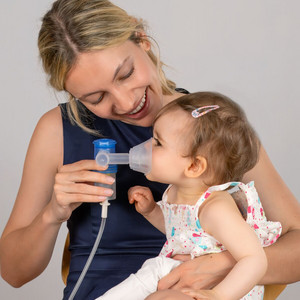
With acute or chronic respiratory diseases, inhalation therapy is also sometimes unavoidable, even for infants. Inhalation therapy with their baby can also be a challenge for parents, but it does not have to be. Because with the right tricks, it is an easy and effective process.
Infants may need inhalation therapy because of acute respiratory diseases, such as RSV bronchiolitis, colds or a stuffy nose, or also for chronic diseases affecting their airways, such as asthma, cystic fibrosis or PCD (primary ciliary dyskinesia). Doctors will prescribe inhalation therapy and the inhalation method depending on the disease.
“Generally speaking, inhalation therapy in children can be either with sprays, such as asthma sprays, or with an inhalation device, such as the PARI BOY Junior” explains Marlies Ziegler. Parents come to her practice with their infants and children who are suffering from chronic respiratory diseases and would like to learn the right inhalation technique.
Inhalation with a spray that dilates the airways must be prescribed by a doctor. However, inhaling saline solution with an inhalation device and nebuliser is something parents can use themselves if their infant has a stuffy nose or a cough. They should, however, go to a paediatrician to look into what is causing the airway problems.
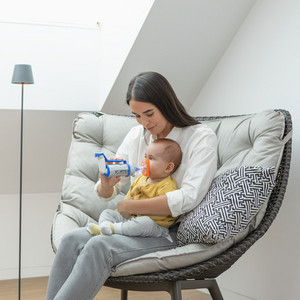
“When inhaling sprays you need to use a spacer (also called a holding chamber) with a suitable baby mask. This is because it is virtually impossible to harmonise releasing the spray when the infant breathes in. Aside from that, infants cannot coordinate sealing their mouth around the mouthpiece of the spray. They are just too small to do that. With With spray inhalation with a spacer and mask, the infants can inhale the medication in several breaths. This generally ensures that – as with children and adults – it reaches the bronchial tubes and does not stay in the mouth, where it may trigger oral thrush as a side effect”, explains the physiotherapist.
With inhalation therapy with your infant it is also important that you use a well-fitting baby mask. That makes it easier to use and ensures that the inhalation mist reaches your baby’s bronchial tubes. Thanks to the practical BABY Bend of the PARI BOY Junior, your baby can also do the inhalation lying down.
Marlies Ziegler has another tip: “A nozzle insert is also very highly recommended – ideally one that generates really small droplets. The airways of infants are still very small and narrow. This means: The smaller the droplets, the more easily they can reach the baby’s bronchial tubes. With the PARI BOY Junior, the red nebuliser nozzle insert, for instance, generates the smallest droplets.”
Some parents wonder at which age their baby can start inhalation therapy. The answer is clear: “from birth”, according to Marlies Ziegler, the respiratory physiotherapist. “Inhalation with a nebuliser is, for example, one of the standard treatments for premature infants after they are born to positively support their lungs. Newborns with heart defects also have inhalation therapy, while babies with cystic fibrosis tend to start the therapy as soon as they are diagnosed.”
How do I hold my baby when I am doing the inhalation therapy with them? This is a question a lot of parents ask. Marlies Ziegler provides inhalation therapy with infants in her practice and coaches parents.
Here are some tips from the respiratory physiotherapist:
For the inhalation therapy, lie your baby on their changing table. This way, you do not have to hold your child, but can keep a close eye on them all the time – so that you can check, for example, that the mask is fitted properly. A mobile over the changing table helps distract your baby and keep them busy so they can get through the inhalation or simply speak to your baby.
Your baby can have the inhalation therapy lying flat on their back or you can pop a cushion, such as a nursing pillow, under your child so that they are lying at an angle. The inhalation therapy can also be performed with the baby lying on their side. During the inhalation therapy feel free to occasionally change your baby’s position. This has the advantage that the different areas of the lungs are ventilated in different ways and the inhaled substance reaches them accordingly. If there is a buildup in mucus, moving your baby during the inhalation therapy also helps mobilise the secretions. Place the mask over your baby’s mouth and nose and let them breathe in and out into the mask.
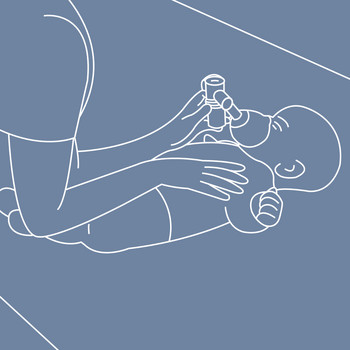
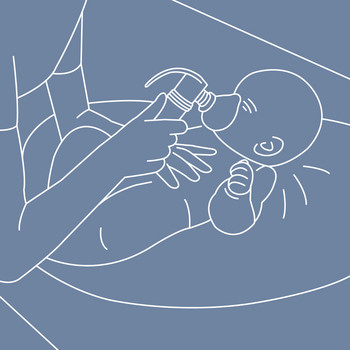
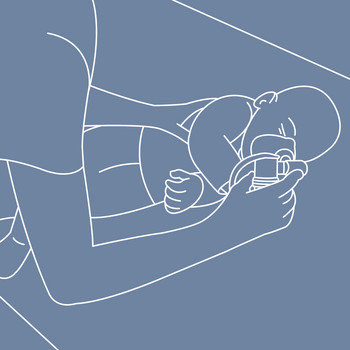
Sit down on a comfortable chair with a back rest and put your feet up on a footstool. Lie your baby on their back on your legs. Your baby’s legs are resting on your tummy. There are also various options for inhalation therapy on your lap. Either your baby lies flat on their back and looks at you or you can turn them on their side. Then support your child’s back with your hand and stabilise them. Place the baby mask gently over your child’s mouth and nose and let them breathe in and out into the mask.

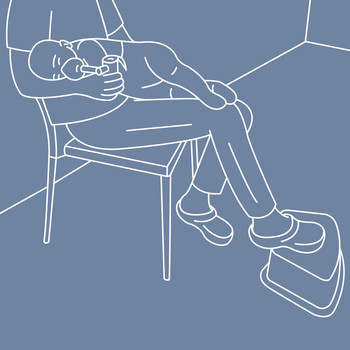
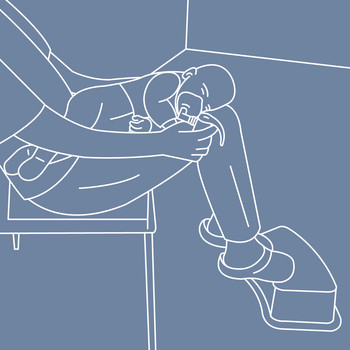
If your baby is already a few months old and is starting to sit, you can sit them upright on your lap and rest their back against your arm. You can vary the position. Lie your child at a slight angle on your arm which you can support with a nursing pillow, for example. This position is more comfortable for you if you rest one leg on a footstool. Your child will then lean partly on the thigh of the leg propped up on the stool and lies mainly on your other leg. After a while you can switch legs and change your baby’s position. Place the baby mask back on your child so that it covers their nose and mouth, and let them breathe through the mask.
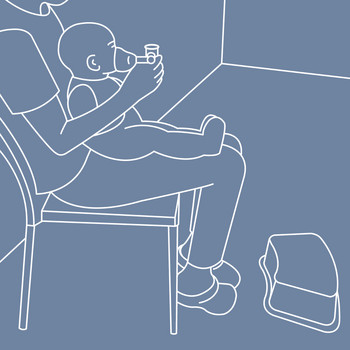
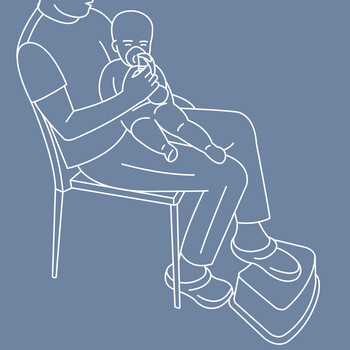
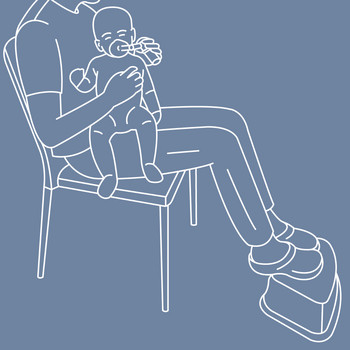
Inhalation therapy can sometimes be strenuous for infants. “The greatest challenge is if the baby cries or screams, moves around a lot or wants to play with the inhalation mask. The sounds the inhalation device makes, on the other hand, are rarely a problem for infants” explains Marlies Ziegler.
The physiotherapist has many tricks up her sleeve on how to make inhalation therapy with infants more stress-free.
If the parents themselves are stressed at the thought of the inhalation therapy, the baby will sense this and will pick up on their mood. So relax and approach it calmly.
An effective inhalation device such as the PARI BOY Junior not only has the advantage that the mask fits perfectly for every age of infant; the device also releases a fine mist and is fast. This makes the inhalation time as short as possible with the greatest possible effect.
Your baby should be in a calm and positive mood when you start the inhalation therapy. This is because your child should associate the inhalation with positive or neutral and not negative feelings. This is especially important for children with chronic respiratory diseases who will have to use an inhalation therapy all their lives.
For the same reason that you do not want the inhalation therapy to be associated with negative feelings, you should interrupt the inhalation if your infant starts crying or screaming. Also, the inhalation therapy will not be doing much in this case. Because when a baby screams, the airways close and the inhalation solution cannot reach deep in the bronchial tubes.
If your baby completely rejects the inhalation and it is never possible to do the inhalation therapy without them crying or screaming, an emergency solution would be to do it when they are asleep. However, we do not breathe as deeply when we are asleep and so the inhalation is not as effective as when awake. In children with chronic respiratory diseases, this trick should ideally not be used. Because they have to get used to the inhalation and accept it, as they will depend on the therapy for their whole lives.
Inhalation therapy can be strenuous for infants. This is why it is advisable to factor in breaks and only to continue the inhalation therapy when your baby has recovered a little. Breaks do not have a negative impact on the inhalation therapy. The inhalation therapy should also be ended on a high note. As soon as you notice your child becoming restless and about to start crying, it is advisable to stop. The reason for this is that your baby should not associate the inhalation therapy with negative feelings.
If you often have problems inhaling with your baby it is helpful to seek support. Your child’s health should be worth a visit to a practice for respiratory physiotherapy to show you how to inhale properly with your baby. For certain chronic respiratory diseases such as cystic fibrosis the doctor can also issue a prescription for respiratory therapy.
The doctor will decide which medications your child should inhale. As a matter of principle, babies can always inhale isotonic saline solution isotonic saline solution but hypertonic saline solution is also suitable for infants.
Im Internet wird häufig die inhalation with hot steam as a natural inhalation method. With this method, table salt is dissolved in boiling water and the hot steam is inhaled. Aside from the fact that it is only the water that evaporates while the salt stays behind in the pot and does not reach the lungs, this inhalation method is fraught with risks.
Whether it is over a cooking pot or in a plastic inhaler: Hot steam is not only extremely unpleasant for infants and children, but also dangerous. Breathing in hot steam can lead to burns on the sensitive baby skin. If the infant moves around a lot and accidently grabs the hot container or it even spills, this can result in serious scalding and burns. Paediatricians urgently warn against inhalation with steam.
This article was written in cooperation with Marlies Zieger. She works as a physiotherapist in private practice in Munich. She specialises in respiratory therapy. She has been treating patients with chronic obstructive and restrictive airway diseases such as asthma, COPD, cystic fibrosis (CF) and primary ciliary dyskinesia (PCD), for more than 20 years.
Note: The information in this blog post is not a treatment recommendation. The needs of patients vary greatly from person to person. The treatment approaches presented should be viewed only as examples. PARI recommends that patients always consult with their physician or physiotherapist first.
An article written by the PARI BLOG editorial team.
© 2025 PARI GmbH Spezialisten für effektive Inhalation